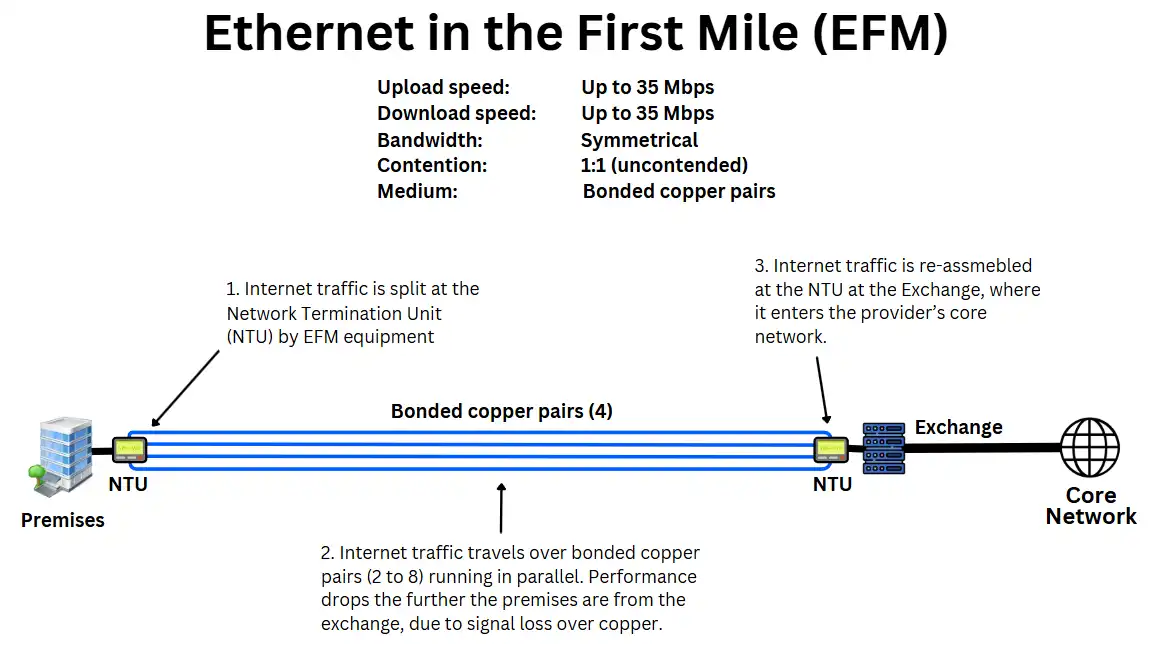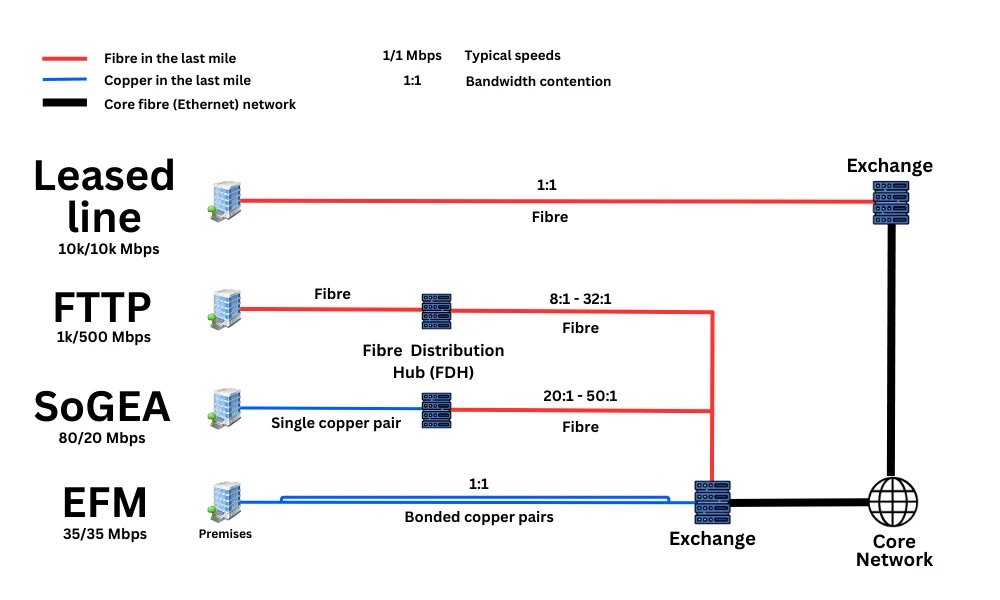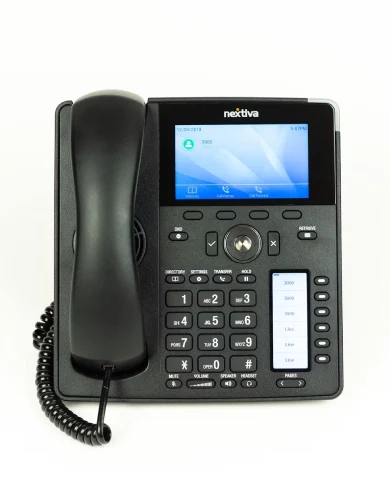Business Ethernet in the First Mile (EFM)
What do you do when your business site needs Ethernet-grade connectivity, but you’re stuck in a fibre dead zone?
Enter Ethernet in the First Mile (EFM): a solution that delivers dedicated, symmetrical broadband over legacy copper infrastructure, with native integration into parent company Ethernet WANs.
This guide covers how EFM works, when and where it’s suitable, how it compares with competing connectivity options, and what it costs.
Contents:
- What is Ethernet in the First Mile (EFM)?
- How does EFM work?
- EFM vs traditional business broadband
- Why should a business get Ethernet in the First Mile (EFM)?
- When is EFM not the most suitable solution for businesses?
- Ethernet in the First Mile (EFM) costs
What is Ethernet in the First Mile (EFM)?
Ethernet in the First Mile (EFM), sometimes known as ‘Ethernet Lite’, is the lower tier of Business Ethernet services.
It delivers fully dedicated, symmetrical, SLA-backed Ethernet-native connectivity to businesses without requiring fibre optic cables in the last-mile stretch from the cabinet to the premises.
This is ideal for integrating business sites in fibre dead zones to the parent company Ethernet wide area network (WAN), or as a standalone uncontended broadband service with premium guarantees, behaving much like a non-fibre leased line.
What EFM lacks in bandwidth and scalability, it makes up for in exclusivity, stability and support. An EFM service can compete with typical broadband services of underserved areas, such as SoGEA, business mobile broadband and business satellite broadband.
EFM isn’t suitable for bandwidth-heavy workloads, but it excels at supporting lighter, real-time business applications like small business VoIP, video calls, and cloud collaboration tools.
How does EFM work?
Ethernet in the First Mile (EFM) uses bonded copper pairs to deliver dedicated, symmetrical Ethernet-native connectivity from the business premises to the local exchange.
EFM can be used to provide either:
- A dedicated business broadband connection, or
- A private Ethernet link into a parent company’s wide area network (WAN).
Bonded copper pairs

Bonded copper involves laying multiple standard telephone lines (called pairs) between your premises and the nearest local exchange managed by your provider.
These lines operate in parallel, much like lanes on a motorway. Each pair carries data independently, but together they form a single logical connection, increasing throughput and improving resilience.
EFM equipment is installed at both ends of the line, one at your premises’ modem or NTU (Network Terminal Unit), and the other at the exchange. The data is split across the bonded copper pairs and reassembled at the other end.
This setup boosts bandwidth without relying on fibre infrastructure at the premises. And because the connection runs directly to the exchange, bypassing any shared cabinets, it creates a fully dedicated link, just like a leased line connection.
Once data reaches the exchange, it connects to the provider’s fibre core for public internet access or integration with a private Business Ethernet WAN.
Key features of bonded copper pairs
Bonded copper pairing is a clever technique to scale legacy copper connections. It boosts bandwidth, resilience and exclusivity, but it’s still limited by the inherent limitations of copper wires.
Unlike fibre optics, bandwidth degrades with distance, maximum throughput is relatively low, and it is vulnerable to electromagnetic interference and an ageing infrastructure.
Here’s the key positive and negative features of bonded copper pairs:
Copper scalability
Depending on availability and line quality, 2, 4, 6 or more copper pairs can be bonded. More pairs = higher total bandwidth. However, overall scalability is constrained and still far below fibre capabilities.
Resilience
If one pair in the bundle fails or becomes unstable, the remaining pairs continue to carry traffic. This reduces overall bandwidth, but prevents total service loss. It’s a basic form of line-level fault tolerance that is useful, but not as robust as the built-in redundancy options available with leased line failover.
Symmetrical speeds
EFM provides equal upload and download speeds, which is essential for real-time cloud applications like VoIP, UCaaS, and video collaboration.
Distance-sensitivity
Performance drops significantly as distance from the exchange increases. Long copper runs introduce signal attenuation, reducing speed and reliability in fringe or rural areas.
Signal degradation
Copper lines are more prone to interference from moisture, EMI (Electromagnetic Interference), and physical deterioration, particularly in rural areas or where infrastructure is ageing.
Leverages existing copper
EFM can often be provisioned using spare copper pairs already connected to the premises, which may reduce installation time and costs. However, viability depends on the number and condition of available lines. Installations may still take several weeks.
EFM vs traditional business broadband

Ethernet in the First Mile (EFM) is often positioned as a business-grade alternative to traditional broadband, offering a unique middle ground between standard contended broadband and fully dedicated leased lines, both in terms of cost and performance.
Below is a comprehensive comparison:
| Technology | Medium (Premises to exchange) | Bandwidth (Typical up/down) | Latency | Contention (Est.) | Cost |
|---|---|---|---|---|---|
| EFM | Bonded copper | 35/35 Mbps | Low | 1:1 | £££ |
| SoGEA (FTTC) | Single copper | 80/20 Mbps | Medium | 20:1–50:1 | £ |
| Virgin Cable | Coax-cable | 1k/100 Mbps | Medium | 20:1–50:1 | ££ |
| Full Fibre (FTTP) | Contended fibre | 1k/500 Mbps | Low | 8:1–32:1 | ££ |
| Leased Line | Dedicated fibre | 1/1 Gbps | Very Low | 1:1 | ££££ |
EFM vs. full fibre leased lines
Only EFM and leased line broadband can offer Ethernet-ready connectivity suitable for native WAN integration.
Both offer fully dedicated connections backed by business-grade SLAs, ensuring consistent performance and premium support.
Put simply, EFM is the entry-level Ethernet option, typically used when full fibre leased lines are unavailable or unviable due to long lead times or high installation costs.
Here is the detailed comparison:
| Feature | EFM | Leased line |
|---|---|---|
| Connection type & medium | Dedicated Ethernet over bonded copper pairs (2, 4, 6, or more). Connects to provider via copper lines directly to the local exchange, then into their Ethernet core. | Dedicated Ethernet over fibre-optic cable. Connects directly to provider’s fibre core network or nearest PoP (Point of Presence). |
| Bandwidth options | 2/5/10/15/20/35 Mbps symmetrical | 10/50/100/500/1k/10k Mbps symmetrical |
| Bandwidth contention | Uncontended (1:1) | Uncontended (1:1) |
| Latency | ~10–30 ms | ~1–5 ms |
| Resilience | Resilient due to bonded pairs – if one fails, others continue operating with reduced bandwidth | Can include additional resilience options like dual circuits, auto-failover, and diverse routing (provider-specific) |
| SLAs | Business-grade SLA. Typically 7 to 8 hour fix time within business hours | Enterprise-grade SLA. Typically 4 to 6 hour fix time, with 24/7 monitoring and support |
| Scalability and Future-Proofing | Limited – constrained by number and quality of copper pairs available | Scalable – designed for future bandwidth upgrades and high-growth demands |
| Installation Requirements | Requires provisioning of multiple copper pairs. Engineer visit needed. May not be viable if additional spare pairs are unavailable | Requires fibre survey. May involve civil works, wayleave permissions, and trenching if no existing fibre route |
| Installation time | 30 - 60 days | 45 - 90 days |
| Monthly cost | £150 to £400 | £300 to £800+ |
| Upfront costs | Moderate. | Higher, especially with engineering works |
| Real-time activities | Suitable for VoIP, UCaaS, CRMs, remote desktop, light conferencing | Excellent for all real-time services |
Why should a business get Ethernet in the First Mile (EFM)?
EFM has always been a niche solution: a specialised connectivity option for businesses that need Ethernet-grade performance in locations where fibre isn’t available, affordable, or practical.
There are two main reasons why businesses get EFM:
1. Integrating remote sites into parent company WANs
For multi-site organisations using a centralised Business Ethernet network, EFM provides a seamless way to integrate remote or rural branches with existing copper connections into the corporate WAN, even if fibre is unavailable or too expensive.
This allows them to easily inherit WAN features like firewalls and Ethernet-native secure gateways.
Other broadband services (e.g., ADSL or even full fibre business broadband) cannot natively connect to private Ethernet-based WANs, unless these rely on alternative WAN technologies such as MPLS and SD-WAN.
2. Delivering Ethernet-grade broadband in fibre-poor areas
EFM offers Ethernet-grade broadband in underserved locations, meaning symmetrical, uncontended (1:1), and backed by robust SLAs.
This makes it a compelling alternative to traditional and wireless options (e.g., 4G/5G business broadband) which are increasingly common in rural or fibre-poor areas, but still lack the consistency of a dedicated line.
Even where fibre is technically available, EFM is often selected when fibre business broadband installation involves excessive lead times, high civil engineering costs, or complex permissions (e.g. wayleave).
While EFM tops out at around 35 Mbps, its reliability and low latency make it well-suited to cloud-reliant businesses that depend on high VoIP call quality and other real-time applications.
When is EFM not the most suitable solution for businesses?
EFM is rarely the most practical or cost-effective option outside of a few Ethernet-specific use cases. In most scenarios, a mix of standard broadband solutions offers greater flexibility, higher bandwidth, lower costs, and faster deployment, especially for SMEs, remote-first teams, and rural sites.
The reality is that more adaptable, cloud-based solutions increasingly overshadow EFM’s limited scalability, fixed location, and higher relative cost.
Here are some of the key scenarios where EFM is not the right choice:
1. When standard (dual) broadband is sufficient
For many small businesses, an affordable SoGEA or FTTP line paired with 4G/5G, or Starlink as a backup offers more bandwidth and resilience than EFM at a much lower cost and with less complexity.
This dual-broadband setup provides higher speeds, comparable latency, and better redundancy, ideal for business VoIP phone systems and general business use.
It only requires a Multi-WAN business broadband router and can often be deployed in just a few days without the need of any engineer visits.
These setups can still integrate with a business WAN using SD-WAN solutions or SASE, enabling secure, optimised traffic over non-Ethernet internet connections.
2. For remote-first businesses
Many businesses today are fully remote or operate hybrid models, relying on cloud-based tools and distributed access. EFM is tied to a single location and offers no real advantage to remote users.
With SD-WAN or Zero Trust Network Access (ZTNA), remote workers can secure and optimise access across any standard broadband link.
3. For high bandwidth operations or growing businesses
With speeds capped at around 35 Mbps and performance degrading with distance from the exchange, EFM is poorly suited for bandwidth-heavy workloads or growing businesses.
This includes teams regularly handling large file transfers, syncing databases between sites, or backing up systems to cloud storage. In these scenarios, fibre-based connections are significantly more capable and future-proof.
Ethernet in the First Mile (EFM) costs
The cost of EFM generally sits in the mid-range between standard business broadband and leased lines. It was originally designed to provide businesses with a more affordable Ethernet-grade service where fibre wasn’t available or practical.
Typical monthly cost
For most UK businesses, EFM typically costs between £150 and £500 per month, depending on bandwidth, location, and provider.
Factors affecting EFM costs
Several factors influence both installation and monthly pricing:
- Number of bonded copper pairs: More pairs = higher throughput and line rental and provisioning costs.
- Distance from the local exchange: Greater distance often requires more pairs or signal conditioning, increasing cost.
- Location: Urban areas with robust copper infrastructure tend to be cheaper. Rural or semi-rural sites may face longer lead times or additional engineering costs.
- Contract length: Longer-term contracts (e.g. 36+ months) often reduce monthly costs or waive installation fees.
- Service level agreement (SLA): Faster fix times and 24/7 support may increase monthly rates slightly.
EFM vs leased line costs
EFM is positioned as a lower-cost alternative to full fibre leased lines, ideal for businesses that need Ethernet-level performance but have existing copper infrastructure.
It costs less in both installation and monthly fees. However, EFM’s limited scalability can lead to higher costs, especially if fibre eventually needs to be installed to support business growth.
Read more about leased line broadband prices to see how it compares.
Here are more details:
Installation costs
- EFM: £200–£800. Sometimes waived on longer contracts. Costs may be higher in rural areas or where spare copper is unavailable.
- Leased line: £0–£3,000+, depending on fibre availability and any civil works (e.g. ducting, trenching). Some providers absorb leased line installation costs on 3–5 year terms.
Monthly costs
- EFM: £150–£500, based on bonded pairs, location, and SLA.
- Leased line: £250–£1,000+, depending on speed (100 Mbps–10 Gbps) and SLA tier.
Upgrade costs
- EFM: High. Upgrading often requires switching to fibre or adopting wireless alternatives like 5G or wireless leased lines.
- Leased line: Low. Most providers can scale bandwidth without new infrastructure.

